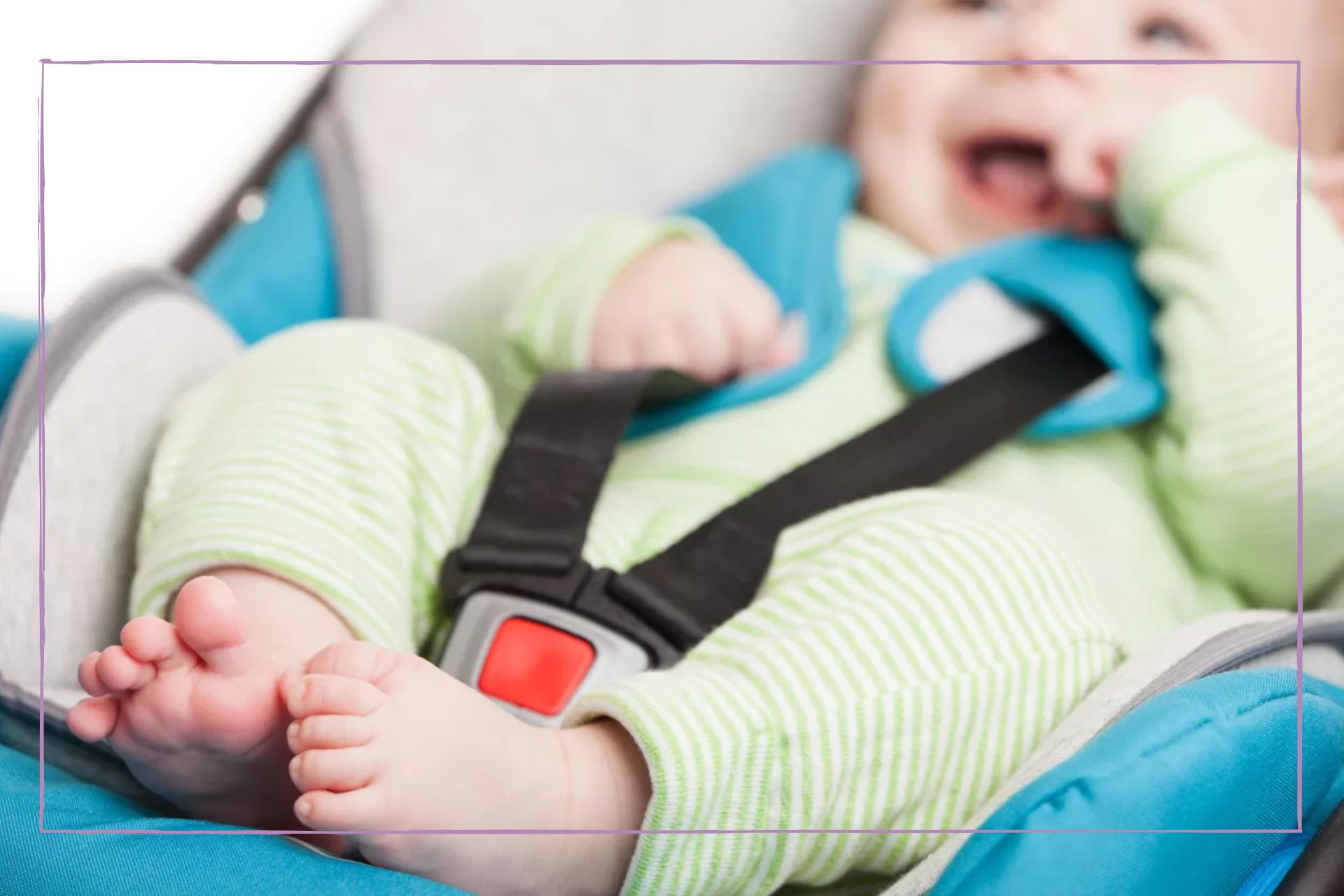How long can a baby be in a car seat? Plus, 7 expert-approved baby travel tips
“How long can a baby be in a car seat?” is an important question ahead of a road trip. Here's how to make your little one’s journey as safe as possible.


Anna Bailey
Travelling with a baby is no easy task, gone are the days of 'popping' anywhere. A trip to your local Tesco is now a military operation. Never fear, we speak to the experts for the easiest and safest ways to travel with your baby.
We know that as a parent, you are a relentless researcher. First off, it will be the best baby car seats or maybe best travel strollers, then things to do with toddlers, followed by - at the teenage stage - the best dad jokes - parents research, a lot. You probably researched this after booking your first family holiday. Well, we're here to make researching that bit easier.
It’s a good thing to wonder about before embarking on a long journey, babies aren't like us, they can't just move around until they're comfortable they need their grown-ups to help move them. Because, while it’s not only vital for you to take regular breaks when driving, it’s important for your little one too.
So make sure you’re stocked up with some of the best-selling baby products of all time and read on to see what our experts have to say about how long a baby can be in a car seat.
How long can a baby be in a car seat?
How long can a baby be in a car seat? is a common question for many new parents. According to the NHS the longest a baby should be in a car seat is two hours. We spoke with baby safety experts who explained this is important to allow babies to stretch and move around. If your baby was born premature or with a low birth weight you should speak to your GP to see whether more frequent stops would be recommended.
Bianca Cain, owner of Safe in Their Seat, a UK-based car seat specialist, says you should build up the time a baby spends in a car seat gradually.
She explains: “For the first 4 to 6 weeks of a baby's life it's recommended to keep the time in their car seat to an absolute minimum, preferably around 30 minutes at a time. This is to reduce the risk of positional asphyxiation and allow them to regulate their temperature better, as car seats can get very hot and sweaty.
Parenting advice, hot topics, best buys and family finance tips delivered straight to your inbox.
“After 6 weeks, it can be extended to around 60 to 90 minutes at a time. This is because they are bigger and stronger and able to better regulate their own temperature and breathing.
“After 6 months, or when baby is sitting unaided, they can spend longer in the car. But we would always recommend taking a break every two hours.”

Bianca Cain is the owner of Safe in Their Seat, a UK-based car seat specialist and retailer. She is committed to helping parents ensure that their child is safe when they travel in the car. She has two children.
The Lullaby Trust, which raises awareness of sudden infant death syndrome (SIDS) and provides expert advice on safer sleep for babies, also advises that while it’s fine for your baby to fall asleep in their car seat while travelling, they should not be left in it once taken out of the car. Instead they should be “placed onto a firm, flat surface to sleep”.
Mum Lucy, who has an eight-month-old son Jacob, says: “We can pretty much guarantee that Jacob will fall asleep the moment we start driving. But we always make sure we transfer him to his own cot or a travel cot once we arrive at our destination.”
7 baby travel tips
Travelling with a baby can be a daunting task, but with the right preparation and guidance, you can make the journey enjoyable and stress-free. Here are 7 baby travel tips;
- Plan around sleep times: Babies thrive on routine, so try to plan your travel around their sleep schedule. If you're flying, consider booking flights during their usual naptime or bedtime to increase the chances of a peaceful journey.
- Pack smart: Pack all the essentials for your baby, but avoid overpacking. Diapers, wipes, baby clothes, formula (if needed), and a few favourite toys are must-haves. Remember that you can purchase certain items at your destination to save space.
- Choose baby-friendly accommodation: When booking accommodations, look for baby-friendly options that provide amenities like cribs, high chairs, and kitchenettes. This can make your stay much more convenient and comfortable.
- Bring a lightweight stroller: A lightweight and compact stroller can be a lifesaver when navigating airports, train stations, and busy streets. Make sure it's easy to fold and carry.
- Research baby-friendly activities: Before your trip, research baby-friendly attractions and activities at your destination. Look for parks, zoos, and museums that offer facilities for changing diapers and feeding.
- Consider babywearing: Baby carriers or wraps are excellent for keeping your hands free while exploring. They can also help soothe your baby, especially during transit.
- Prep for travel discomforts: Babies can experience discomfort during takeoff and landing on flights due to changes in cabin pressure. Breastfeeding, bottle-feeding, or offering a pacifier during these times can help alleviate the pressure on their ears.
Remember that each baby is unique, so adapt these tips to suit your child's needs. Planning ahead and staying flexible will go a long way in making your baby travel experience a memorable one for the right reasons.
What age can a baby be in a car seat longer than 2 hours?
Parents often wonder how soon a baby can travel long distances by car and at what age they can be in a car seat for longer than 2 hours. However, where possible it is not advised that a baby should spend much longer than this in a car seat. This is because the two hour car seat rule aims to ensure that your little one can stretch and be held in an upright position regularly. Also, it’s important that the driver takes regular breaks, especially if they are tired from middle of the night wakings!
Parenting expert Kirsty Ketley explains: “Babies can travel from birth in a car seat. However, it is best that you refrain from long distances until your baby is over 6 months old.
“If you need to do a longer journey, you should take regular breaks to check on them and take the baby out of the seat and put them in the upright position. Ideally, have another adult sitting on the back of the car with them.”

Kirsty Ketley is a parenting specialist who runs a parent consultation service offering support, reassurance, help and advice on all areas of parenting. She is a qualified Early Years Practitioner with more than 25 years experience of working with children from birth to the teenage years. She has two children.
The Lullaby Trust advises using a mirror to keep an eye on your baby if travelling alone. It warns: “If your baby changes its position and slumps forward, then you should immediately stop and take them out of the car seat and reposition them before continuing on your journey.”
Mum-of-two Vicky remembers long car journeys to visit family when her children were babies. She says: “My parents live up north, so we always planned our journeys carefully. We would set off immediately after breakfast and drive for two hours while the baby napped. Then we’d stop for lunch and drive for another two hours, before stopping for an afternoon snack. Then there would just be the final leg of the journey. They were long travel days, but it was better for everyone that we broke the journeys up into small, manageable chunks.”
Of course, it is not always possible to stop if you are stuck in traffic for example, but try your best to stick to the two hour car seat rule where possible.
Parenting expert Nicole Ratcliffe, who is the founder of Baby2Sleep, says: “There is no age when it is advised babies can be in car seats longer than two hours. So, if possible, please follow the two hour rule. However, we do know that in some circumstances with traffic, this isn't always possible. But try to take regular breaks when you can, let baby have a stretch along with yourself, get some blood flow back to the legs and hope that you don't get caught in hours-long traffic jams!”

Nicole Ratcliffe, is a parenting expert and sleep consultant. She is a member of the International Association of Child Sleep Consultants, and studied Holistic Sleep Coaching through BabyEm. She is also founder of Baby2Sleep and mum of two daughters.
How to keep baby safe and comfortable in the car
- Window shades
- A blanket
- A mirror
- Air con/fan
One of the most important things to think about when considering how to keep a baby safe and comfortable in the car is their temperature. If you are driving in hot weather, make sure they are dressed in light clothes and use either air conditioning or a portable fan to keep them cool.
Window shades can also be placed across the windows to avoid glare or overheating. Kirsty says: “Never cover the seat with a blanket or muslin cloth to shade from the sun, instead purchase safety-checked window shades.”
If the weather is cold, do not be tempted to put your baby in a car seat wearing a snowsuit or thick jacket. Instead, cover them with a blanket once they are safely secured with the harness.
The Royal Society for the Prevention of Accidents (ROSPA) explains: “If a child is wearing a thick jacket or body suit the harness cannot be firmly fastened around the child meaning that it will not fit in the right place and importantly it will not be close enough to the child’s body. In an accident, the harness will need to compress the jacket before it can restrain the child. This reduces the safety of the seat considerably and therefore it is not recommended that thick jackets or bodysuits are worn.”
Nicole adds: “Avoid putting hats on your baby in the car seat. Babies struggle to regulate their body temperature and with this comes the risk of overheating. You can always check to make sure your baby isn't too hot by putting the back of your hand on their chest or the back of their neck. If they seem hot or clammy, remove a layer.”
Best toys for car travel
- Soft books
- Cuddly toys
- An activity mat
- Teething toys
The best toys for car travel are soft ones. This is so that baby doesn’t hurt themselves while playing with in and also so that in the event of an accident, it does not cause any damage.
Bianca says: “Remember in a crash everything multiplies in weight and a tissue box can become the same weight as a brick. So heavy toys can cause some serious injury, not just to baby, but to any other passengers in the car.
“Any loose items in the car should be stored away before the journey. No toys or dummy clips should be clipped to the babies harness straps on their car seat as this can risk damaging the straps.”
Instead opt for cuddly toys, or crinkle books. Toys that play white noise or music can be comforting for babies on long journeys. You could also get an activity mat that hangs from the headrest of the facing seat that your little one can kick.
Nicole says: “Make sure that when driving you don’t have anything clipped to the seat and avoid hard toys. You can use the ‘ouch’ test and hit yourself on the head with a toy, if it hurts you then it isn’t safe for baby in the car.”
Car seat safety
Car seat safety is extremely important when travelling with a child of any age, but particularly a baby. You should always make sure that your car seat is installed correctly and that your baby is harnessed correctly.
Follow the manufacturer’s instructions to install your car seat. If you are uncertain of any aspect, ask the staff at the store you purchased it from to show you how to fit it.
Bianca says: “Car seat specialists are available all across the UK. These are independents who are highly trained in car seat safety. So if you purchase your car seat through an independent car seat retailer, they will help ensure that your seat is installed correctly.
“If you have already purchased one you can fully read the car seat manual, as well as watch installation videos that may be available on Youtube.”
It is also recommended that you do not purchase a baby seat secondhand, as you may not know its history or whether it has been involved in any accidents previously. Once you have installed your car seat, you need to make sure that your newborn is harnessed correctly.
Bianca explains: “If using an infant carrier (newborn seat with a carry handle) then baby needs to be scooped fully forwards with their bum so that their nappy is touching the buckle. The harness straps at the baby’s shoulders should be coming out directly level with their shoulder level, not too high or too low. The straps should be pulled nice and snug so that you can just fit one to two fingers by baby’s collarbone area.”
Nicole adds: “Make sure your baby is rear-facing until at least 15 months, so purchase a mirror so you can see your little one from your rearview mirror. Also, make sure you are using the right car seat inserts for your baby's weight and height.”
When is the best time to travel with a newborn baby?
The best time to travel with a newborn baby is usually around nap times. This means that baby will hopefully sleep through and you can have a more relaxing journey. However, you should still make sure that you stop and take breaks regularly, even if your baby is sleeping.
Kirsty says: “It is best to time traveling in between feeds, so that your baby is comfortable and most content. They may fall asleep due to the motion of the car, so don't worry if this is out of sync with their usual routine, but you may want to time your journey with their nap.”
In summary, the two hour rule is a good one to stick to when thinking about how long a baby can be in a car seat. If you would like any more information on any of the above visit ROSPA or The Lullaby Trust.
If you're looking at going away with your family take a look at our how to sit together on a flight for free article or for older kids look at natural remedies for travel sickness and don't miss the clever mum hack of fitting a week's worth of clothing in a carry on case.

Emily-Ann Elliott is an experienced online and print journalist, with a focus on health, travel, and parenting. After beginning her career as a health journalist at The Basingstoke Gazette, she worked at a number of regional newspapers before moving to BBC News online. She later worked as a journalist for Comic Relief, covering stories about health and international development, as well as The Independent, The i, The Guardian, and The Telegraph. Following the birth of her son with neonatal meningitis, Emily-Ann has a particular interest in neonatal health and parental support. Emily-Ann has a degree in English literature from the University of Newcastle and has NCTJ and NCE qualifications in newspaper journalism.
- Anna BaileyEditor in Chief